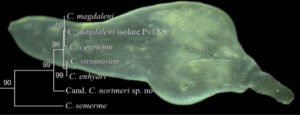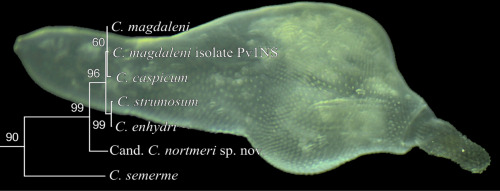Marine Mammal Parasite of the Month- August 2021 Answer
This month’s parasite was the Corynosoma enhydri, a member of the thorny-headed worm community that only has one definitive host, the sea otter. The only way to determine if a sea otter is infected is through a fecal diagnosis or through a necropsy since this parasite does not present any visual signs of infection in the host. However, as with all parasites, a heavy load will cause emaciation and lethargy. There are many different types of thorny-headed worms, or acanthocephalans, and they infect a large range of marine species including pinnipeds, cetaceans, mollusks, fish, and otariids. They all look relatively similar, with an elongated, cylindrical body that forms one larger end and one smaller end. Out of the larger end sticks a small thorny appendage, often called a hook. This is the part where the parasite gets its common name because it does look like a thorn coming out of its head. This part of the parasite will burrow into the small intestines of their host and stay attached there. For sea otters, these parasite burrow into the lining of the small intestine, and in severe cases, can go through the lining of the small intestine and into other body cavities and parts.

Sources:
Berman, J. J. (2012). Acanthocephala. Acanthocephala – an overview | ScienceDirect Topics. https://www.sciencedirect.com/topics/biochemistry-genetics-and-molecular-biology/acanthocephala.
Mayer, K. A., Dailey, M. D., & Miller, M. A. (2003). Helminth parasites of the southern sea otter Enhydra LUTRIS Nereis in CENTRAL California: ABUNDANCE, distribution and pathology. Diseases of Aquatic Organisms, 53, 77–88. https://doi.org/10.3354/dao053077
Shanebeck, K. M., Lakemeyer, J., Siebert, U., & Lehnert, K. (2020). Novel infections of
Corynosoma enhydri and Profilicollis sp. (Acanthocephala: Polymorphidae) identified in sea otters Enhydra lutris. Diseases of aquatic organisms, 137(3), 239–246. https://doi.org/10.3354/dao03442 http://www.marinespecies.org/aphia.php?p=taxdetails&id=448859 https://assets.speakcdn.com/assets/2332/sea_otter_care_manual_2019.pdf https://www.google.com/url?sa=i&url=https%3A%2F%2Fwww.sciencedirect.com%2Fscience%2Farticle%2Fpii%2FS2213224417301141&psig=AOvVaw3mL5tJC1TmtwA79P_trZcL&ust=1627740533751000&source=images&cd=vfe&ved=0CAsQjRxqFwoTCOC83JX8ivICFQAAAAAdAAAAABAD
Posted by summer intern Abby C.





